Wild Cooking Scotland
Foraging and Wild Cooking in Scotland
Kieran Creevy // Photography: Liz Seabrook
This is the third in our foraging and wild cooking series exploring different landscapes and ingredients within the UK. To follow the routes and for more ideas, visit Viewranger.com.
Clouds painted in tones of grey and white stream overhead, hinting at wilder conditions to come. On the verge stand our packs, slowly being filled to capacity with food, firewood, sleeping bags, mats, pots, water and a sneaky bottle of wine or two – all hinting at a long night beside a fire with good friends and full bellies. Ahead of us lies a meandering trail to the deserted village of Peanmeanach and its bothy.
We’re barely underway before our photographer catches splashes of purple and red out of the corner of her eye. Blackberries, ripe and ripening, dot the side of the trail. Tasting the berries, we’re surprised at the difference in tartness between plants just metres apart. It’s not long before two of our canisters are full to the brim.
Shouldering packs again and on the move, we become aware of a musical clanging, and expect at any moment to see a bunch of ski-mad Austrians or possibly alpine cows appear from the forest below. Instead our photographer grins, shrugs and points to the myriad water bottles and tin cups hanging off her pack. Noise? Or perhaps homage to alpine mountains and Mike Oldfield, we don’t know. All we know for sure is that any hint of the name ‘Daisy’ uttered from our lips will result in some serious repercussions.
Descending the trail towards Loch Dubh (Black Lake), we gather handfuls of dried twigs strewn on the path and dotting the undergrowth – good kindling for tonight’s fire. We pause briefly on a tiny concrete bridge, waiting in anticipation for the old Fort William to Mallaig train, which passes underneath with whistle shrieks and clouds of steam. Brief moments of nostalgia are evoked – old movies and stories from parents and grandparents.
ROUTE
Difficulty: Easy
Distance: 11km round trip
Duration: 2 hours each way
A fantastic walk to a deserted village with great coastal views to both sides of the Ardnish peninsula and out towards the Hebrides. A well defined track over rough terrain. Some boggy stretches between the last section of forest and the old village.
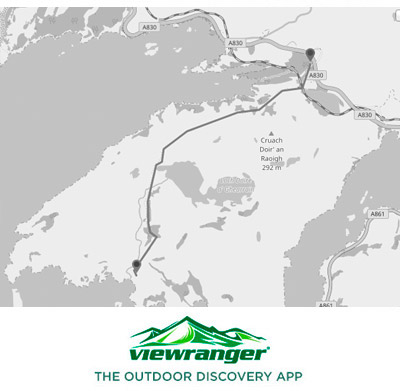

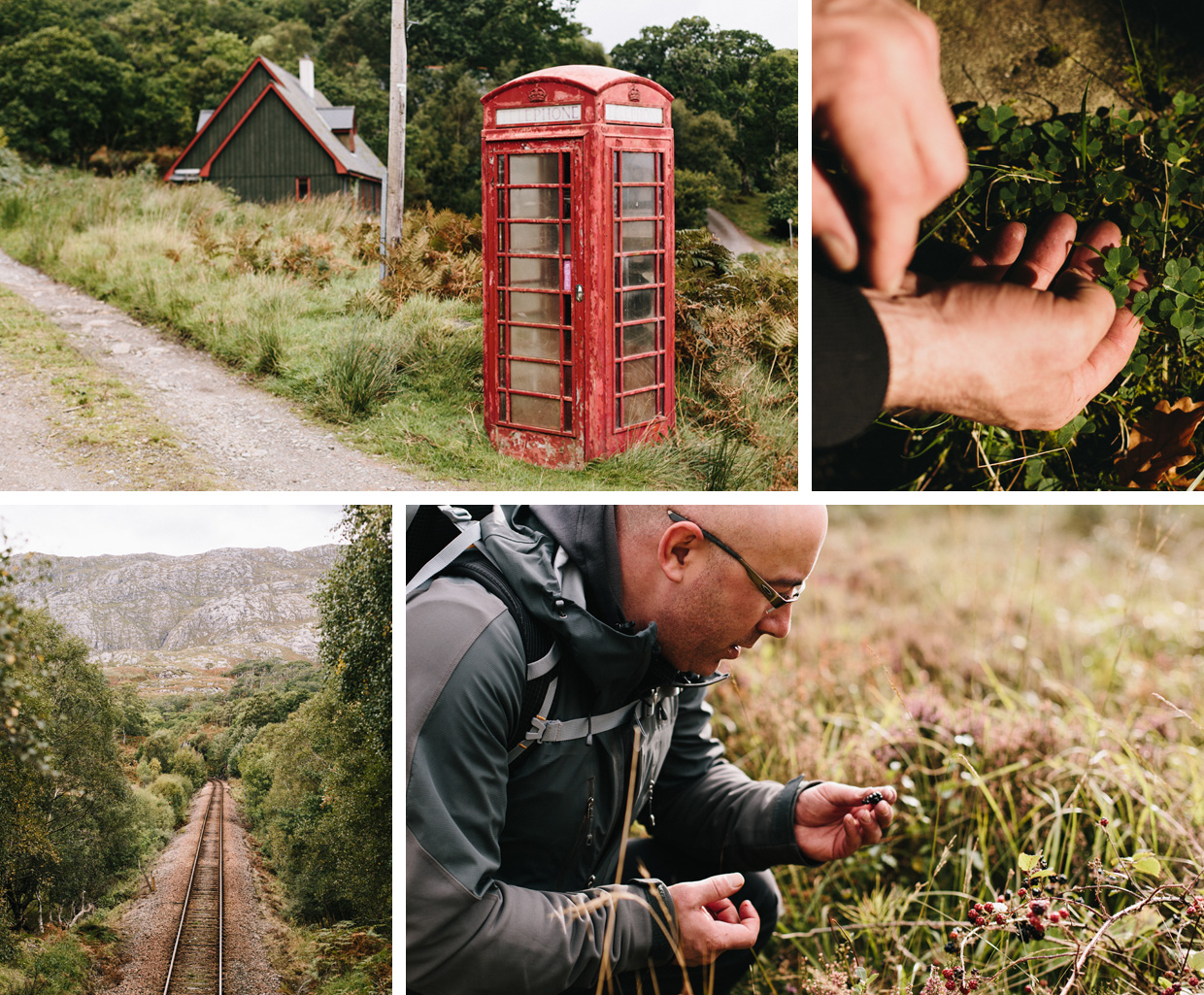
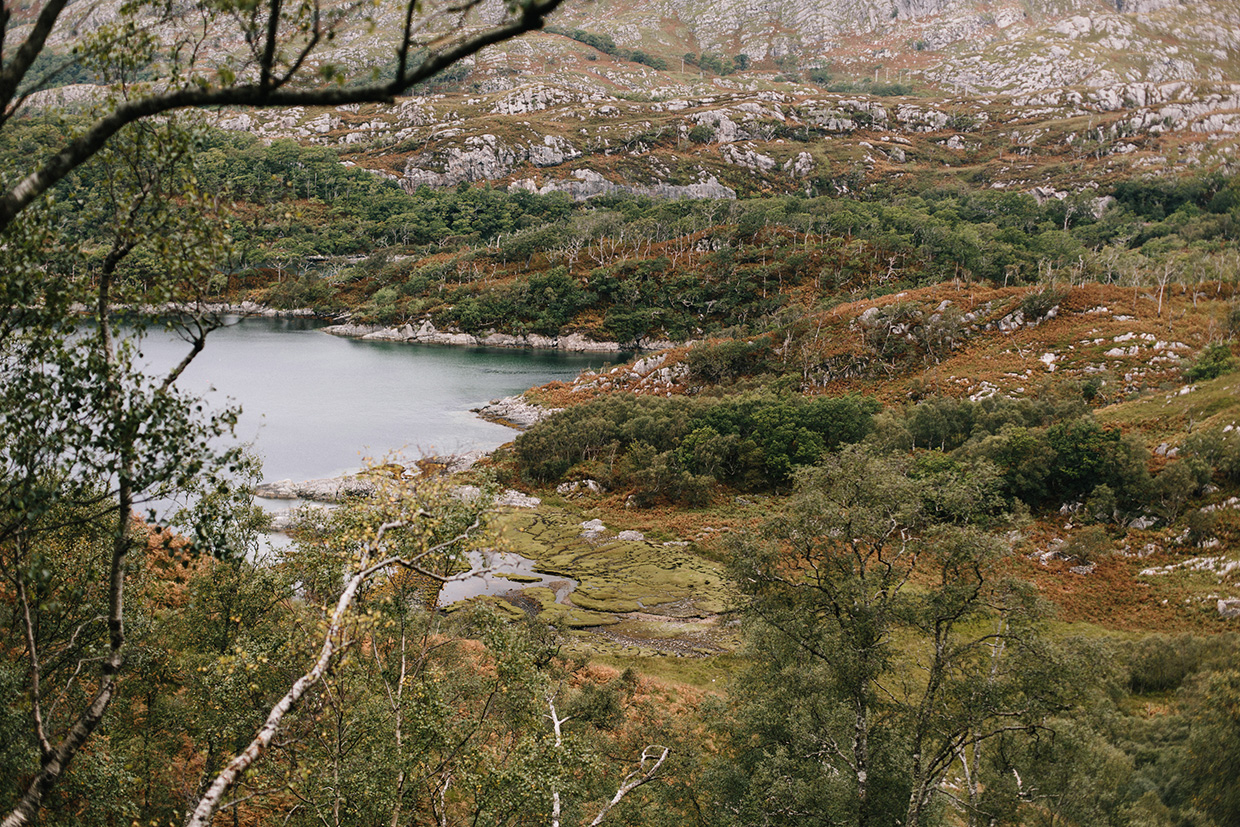
The outdoors fires our imaginations, encourages us to revel in our memories. Tonight we’ll talk about stories from our pasts and dream of moments yet to come.
Scrambling over rocks we emerge onto proper Scottish moorland: hints of heather, purple, brown and dark green, interspersed with the greys and light yellow-greens of lichen-covered stones and boulders. The wind gusts and swirls in from both sides of the peninsula and over small skerries dotting the lochs, Loch nan Uamh to our north and Loch Ailort to the south, recalling lyrics from the Kenneth Macleod song – ‘The Road to the Isles’.
Tacking into the wind, we negotiate brackish pools dotted with stepping stones and slippery stretches of bog, pausing once again to take in the splendour of the view. It seems almost like a caricature of the Scottish Highlands: framed by two rocky crags, a burn tumbles down over water-rounded rocks beside our trail, while below lies our home for the night, a remote bothy, stranded on a shoreline amongst the remnants of a long-deserted village.
Gnarled roots and trunks surround us in the woodland, and here, another find for tonight’s dinner – clumps of wood sorrel, still juicy enough to elicit the taste of a Granny Smith apple skin. Out onto reeds and grassland. The swish and swash of green stems takes John and Liz back to childhood memories of Michael Rosen’s book, We’re going on a bear hunt.
This is what’s amazing about the outdoors. How it fires our imaginations, encourages us to revel in our memories. Tonight we’ll talk about stories from our pasts and dream of moments yet to come.
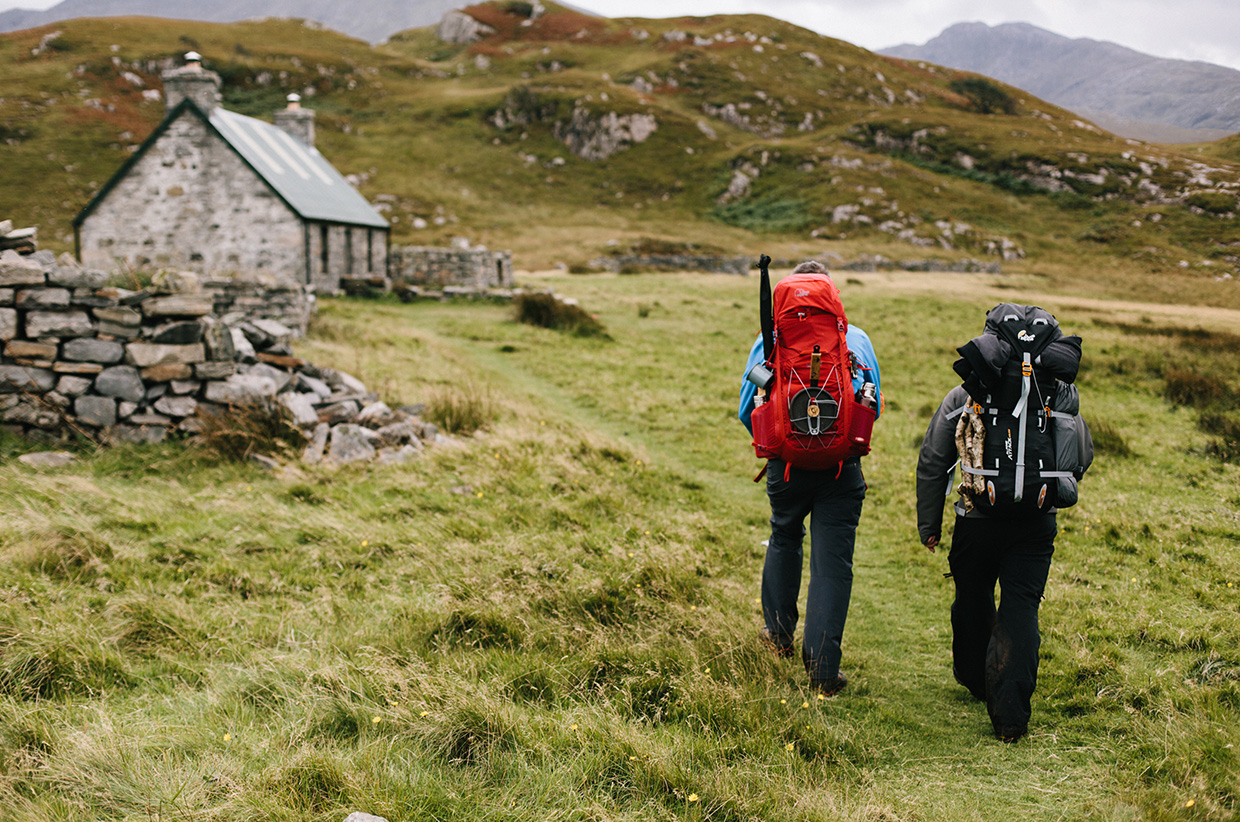
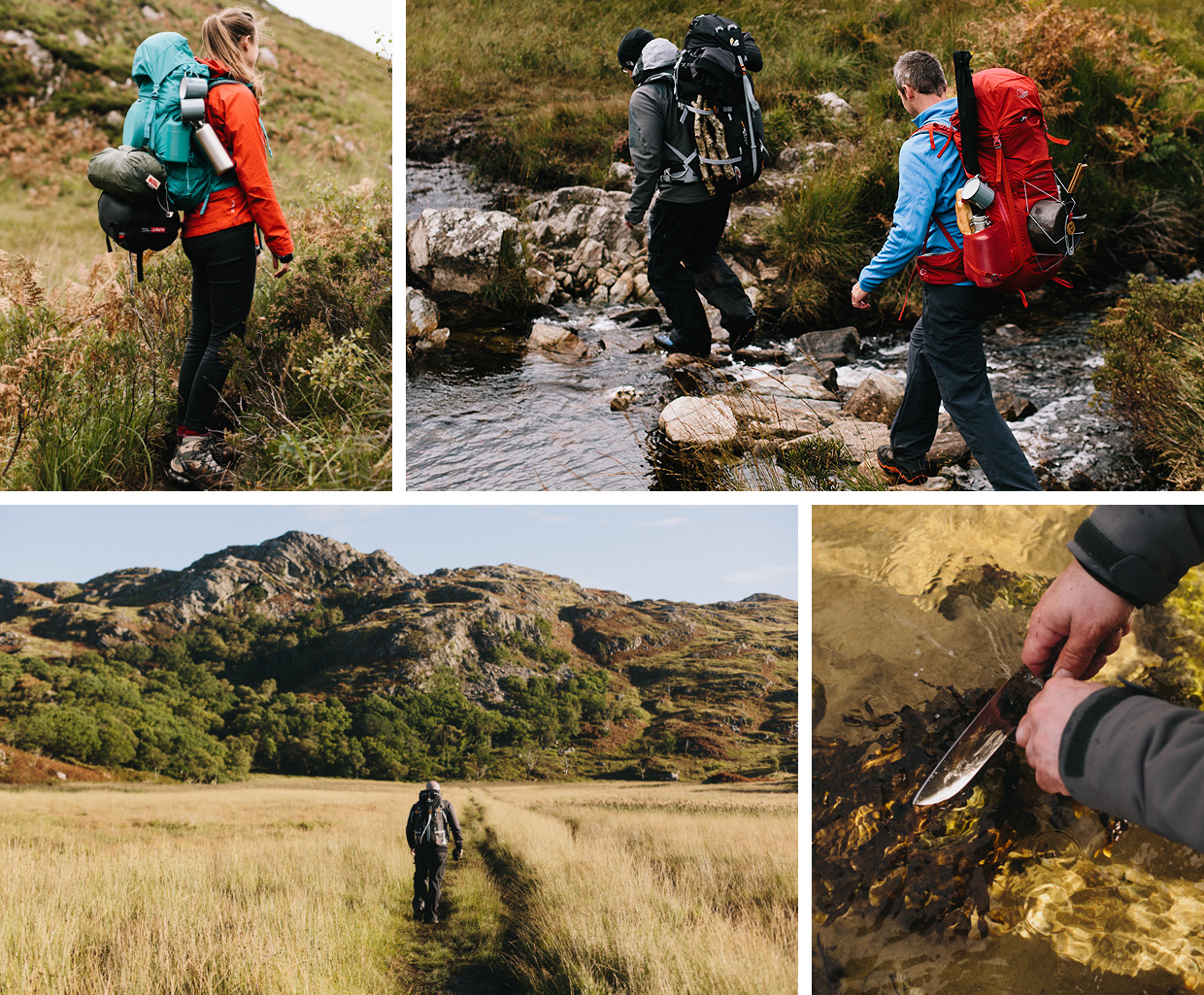
Venison steak with blackberries, mushrooms, beef shin and root vegetable casserole
Ingredients (serves six)
1-2 medium pieces of beef shinbone
6 venison steaks (100-150g)
6 large carrots
2 large parsnips
2 large onions
6 medium potatoes
2 large handfuls of mushrooms (chestnut, button, shiitake, chanterelle, portobello)
2 large handfuls of foraged blackberries
1 large handful of wood sorrel
1 large handful of foraged bladderwrack seaweed, or use dried seaweed such as alaria or dulse
1 bulb of garlic
1/2 to 500ml bottle heavy red wine (Shiraz/Syrah, Cabernet Sauvignon or Pinotage for preference) 1 stock cube
1tsp dried juniper berries
1tbsp harissa paste
1tsp cumin seeds
1tsp black onion seeds Salt and pepper
Fresh or dried thyme and rosemary rapeseed oil
Butter
Seawater, tap or filtered water (there is no tap water at the bothy so you will need to either filter water from the nearby stream or carry in tap water)
Equipment:
Supply of kindling, wood, firelighters, matches or lighter.
Gas or liquid-fuel stove, for a brew and breakfast.
A few candles or tea lights – for atmosphere.
Get a good fire going in the bothy fireplace – you want a strong fire with a good mix of burning logs and embers. Season the venison steaks with salt and pepper. Mash a large handful of blackberries and chop the wood sorrel.
Place in a leak-proof container with the venison steaks. Make sure the venison is well coated with both wood sorrel and the blackberry juice. Place the unpeeled onions directly onto the embers and leave to char, turning once to char as much of the skin as possible. Don’t worry if the first or second inner layer chars as well; this will add to the flavour. Leave to cool slightly, peel off the outer skin and chop roughly.
Wrap 4 potatoes in the bladderwrack and place on the embers. Add 1 chopped onion to a deep heavy saucepan, with a good splash of rapeseed oil. Place on the fireplace’s swing-arm and move over the fire until the onions start sizzling. Season, stir then add the beef shin bone. Cover and allow to roast for 20 minutes.
Meanwhile peel and chop the carrots, parsnips and 2 potatoes. Bring a pan of seawater to the boil on a gas stove, then boil for 5 minutes to make sure you kill any potential germs.
Add the carrots and parsnips to the pot (in batches if necessary). Cook until tender on the outside but undercooked in the centre. Drain and retain the liquid. Remove the potatoes from the fire. Discard any unburned bladderwrack back onto the fire. Dice the potatoes, add the spices, stock cube and wine to the saucepan over the fire. Allow the wine to boil briefly, then add the carrots, parsnips, second onion, potatoes and vegetable cooking liquid.
If the pot is too full, remove the bones, making sure to add any marrow left inside the bone to the pot beforehand. Cover and simmer for 20-30 minutes adding extra filtered water if necessary.
Taste, making sure the vegetables are cooked through, and season if necessary. Cover, place on the embers and leave.
Make sure the fire is well stoked, then using a separate pan melt 2 tbsp butter. Season the mushrooms then add to the pan. Cook for 3-4 minutes, then add to a bowl, keeping warm at the side of the fire. Return the pan to the fire, add a little rapeseed oil and heat to sizzling.
Cook the venison steaks in 2-3 batches to ensure they fry and not poach. Cook only to medium rare or medium as venison is very lean. Allow to rest for 2 minutes, slice and serve with the vegetable casserole, mushrooms, some fresh blackberries and a glass of good red wine.
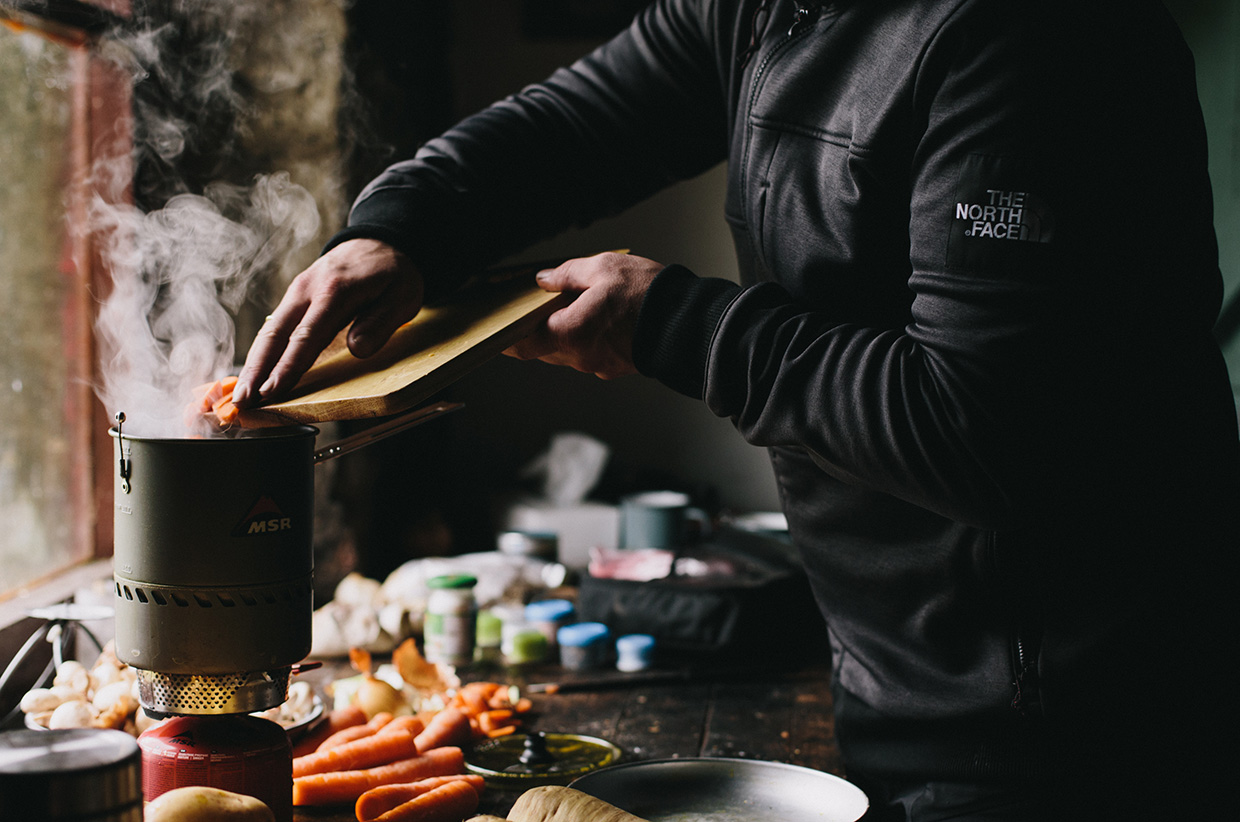
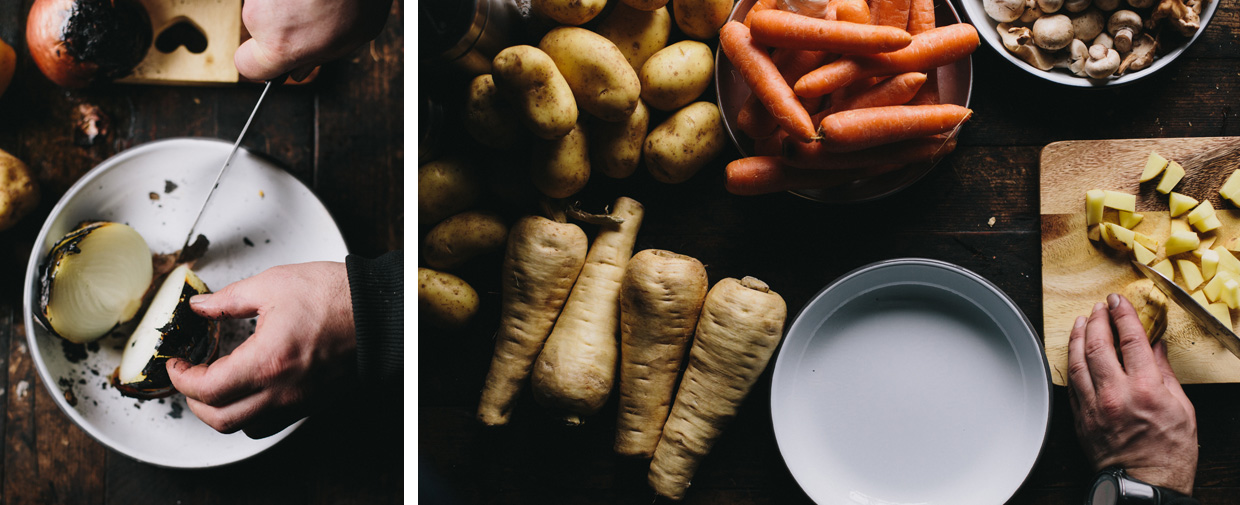
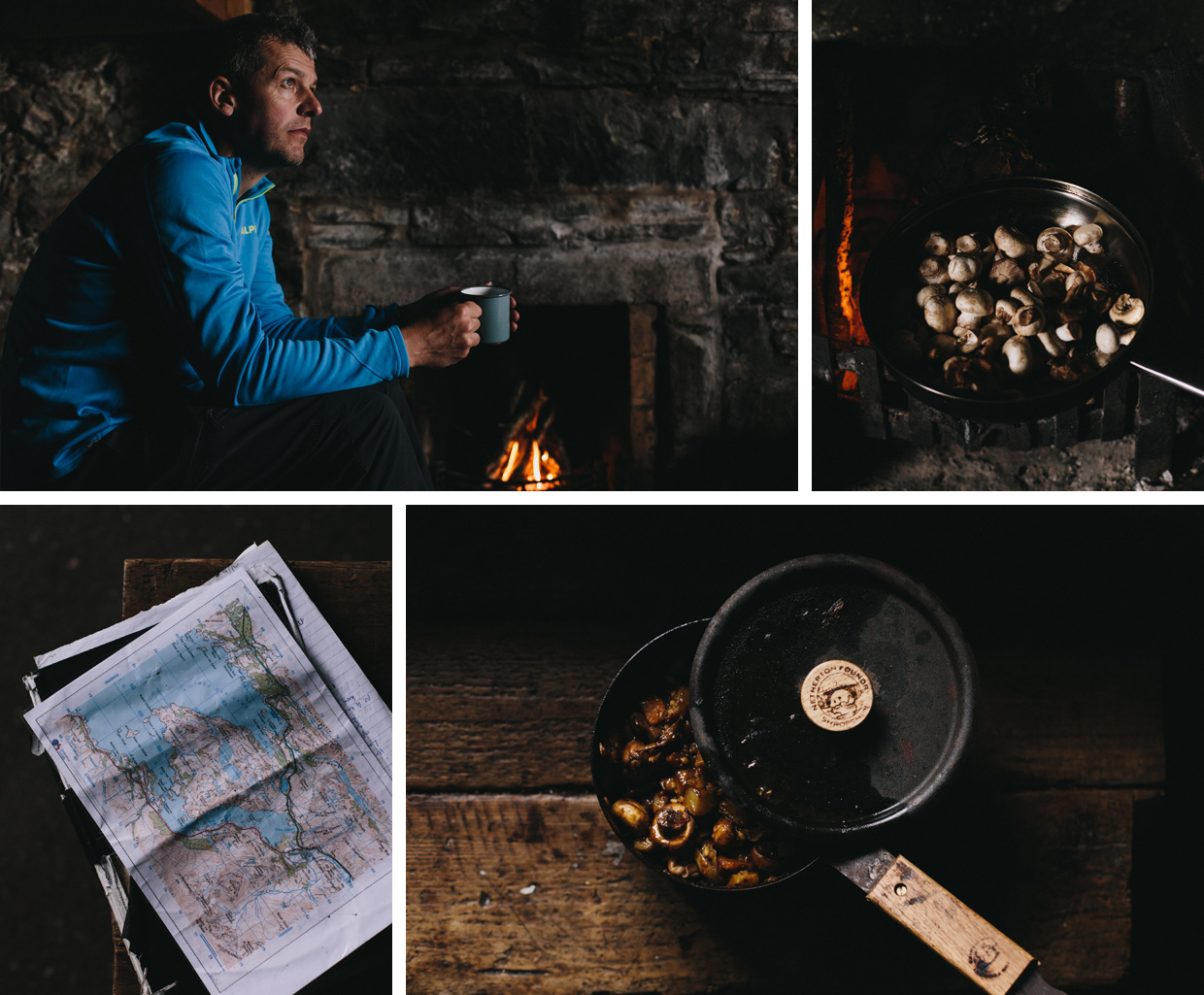
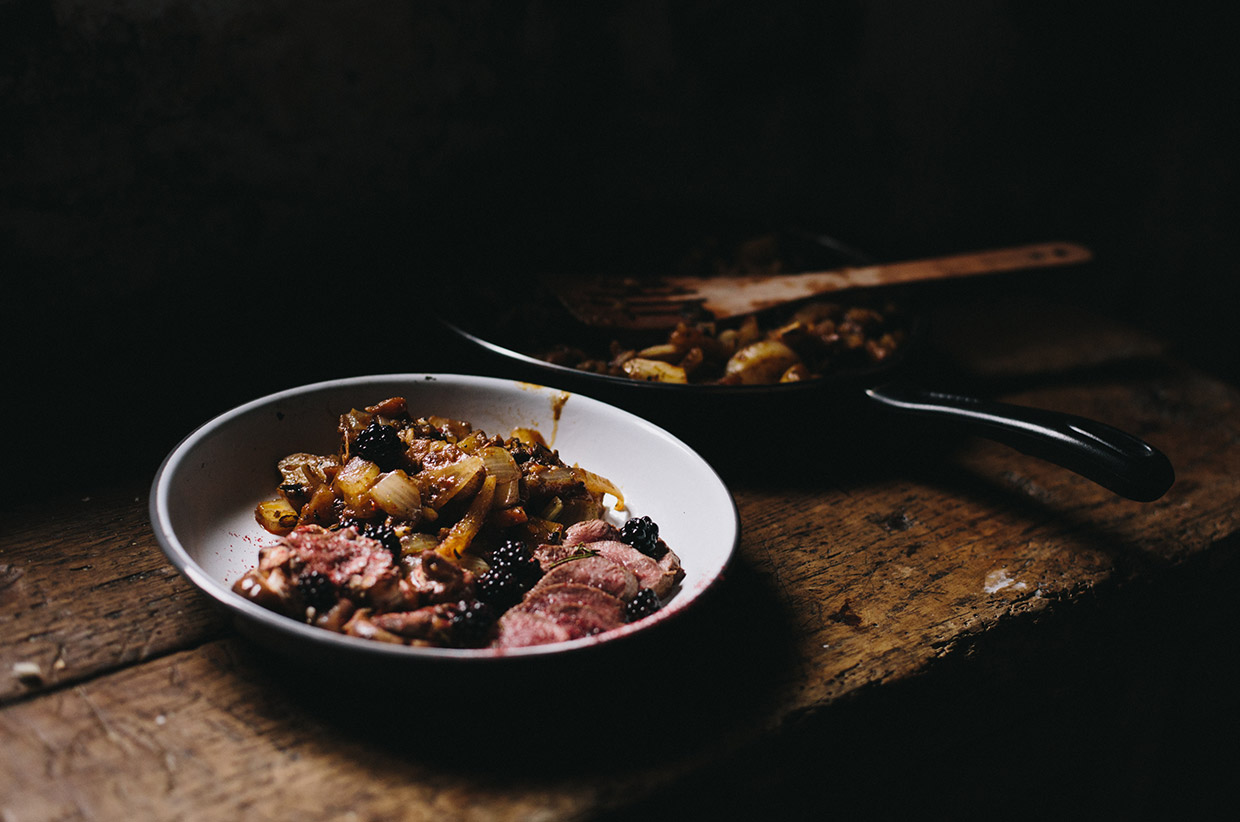
NOTES:
Please follow the Mountain Bothy Association Code when using any Bothy
If you’ve travelled from the south, you might expect the blackberries here to be overripe to the point of turning mouldy, but this far north you have to adjust for the difference in temperature and sunlight.
If you’re taking thyroid medicine, be careful when using bladderwrack or other seaweed (fresh or dried) as they’re very rich in iodine.
When foraging bladderwrack or other fresh seaweed, never pull the entire plant from its placement, be it rock, stone or seabed. Once you do, the plant will die. Instead, cut off a portion of the plant and it will continue to grow.
Identification and Knowledge:
1. Know which plants, fruits and nuts are edible and how to correctly identify them. Do not consume unless you are 100% sure they are safe.
2. Only harvest if you can correctly identify the plant and the surrounding area is not contaminated.
3. Many plants are highly poisonous and can cause death if consumed. Many have poisonous look-a-likes.
4. It’s important to know which parts of each plant are edible.
5. Some plants are only edible after careful preparation e.g. cooking, washing, and removal of sections.
Sustainable Foraging: Where, When and How to Forage:
1. Only pick when a plant is abundant.
2. Use sharp scissors for preference, or a sharp knife.
3. Only harvest in patches, as you need to leave plants for regeneration and its continued survival.
4. Try not to remove flower or seed heads unless sourcing these specifically. Plants form a vital part of the eco-system, and many animals, insects and other organisms rely on them for survival.
COOKING ON AN OPEN FIRE
There is often no wood supply at a bothy so you will need to carry in your stores for the night. The cutting or chopping of any living trees or branches in the area (from the road onwards) is strictly forbidden, and doing so may result in the bothy being closed to the public. You are allowed to collect fallen dead wood, but be aware this may be damp so it’s always advisable to have a backup.
For the full experience, try to cook these dishes over an open fire or on a barbecue. If you’re making an open fire in the outdoors you need to follow a few very important rules:
1. You either need permission to have an open fire or have checked with local regulations.
2. You only need a small fire (dinner plate size) to cook these dishes. Any larger and you’re just using extra fuel for no immediate gain and you may exhaust usable wood in that area.
3. Make sure the wood you’re using isn’t going to impart an unpleasant taste to your food. Apple, Ash, Beech, Birch, Crab-apple, Chestnut and Oak are good options.
4. Only use dead wood, driftwood, or wood that has already been felled. DO NOT cut branches from living trees.
5. Make sure the wood is completely dry, inside as well as out. A simple test is to try and break a twig with one hand. If the twigs snap cleanly with no effort at all, it’s bone dry. If however it bends a lot or requires force to break, it’s still wet – even if the bark feels dry.
6. If you’re cooking over an open fire, moderate the heat under the pan by allowing the wood to cool to coals or by adjusting the height/distance from the heat source.
For in-depth fire making skills, read one of Ray Mears’ books, or check out one of the many bush craft courses available in Ireland, the UK, and around Europe and the US.




